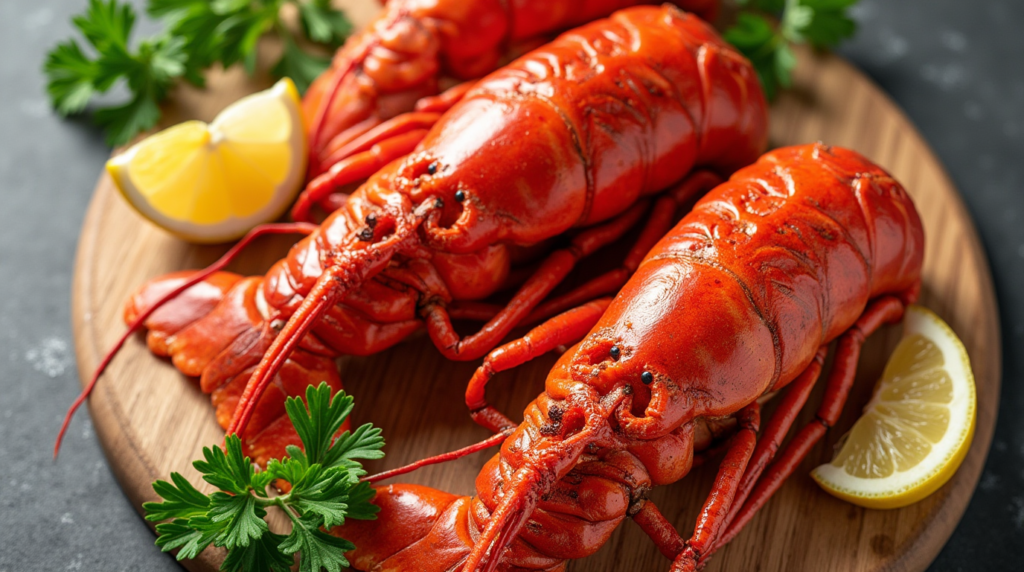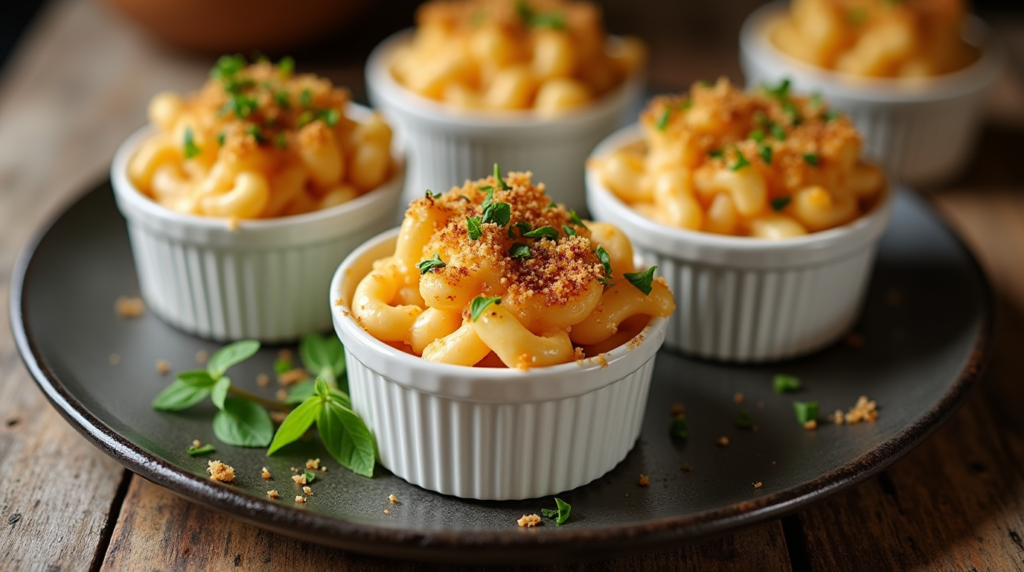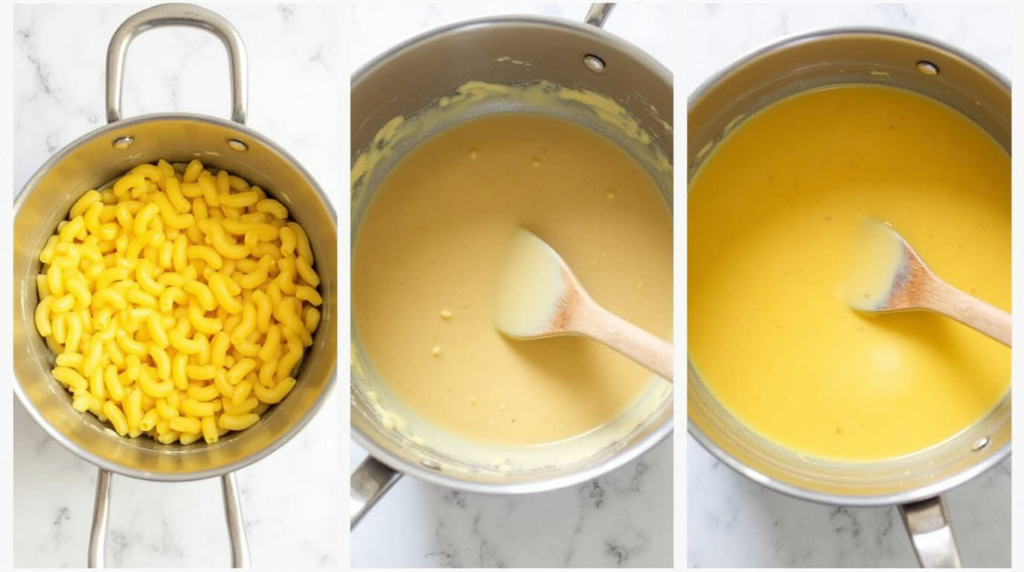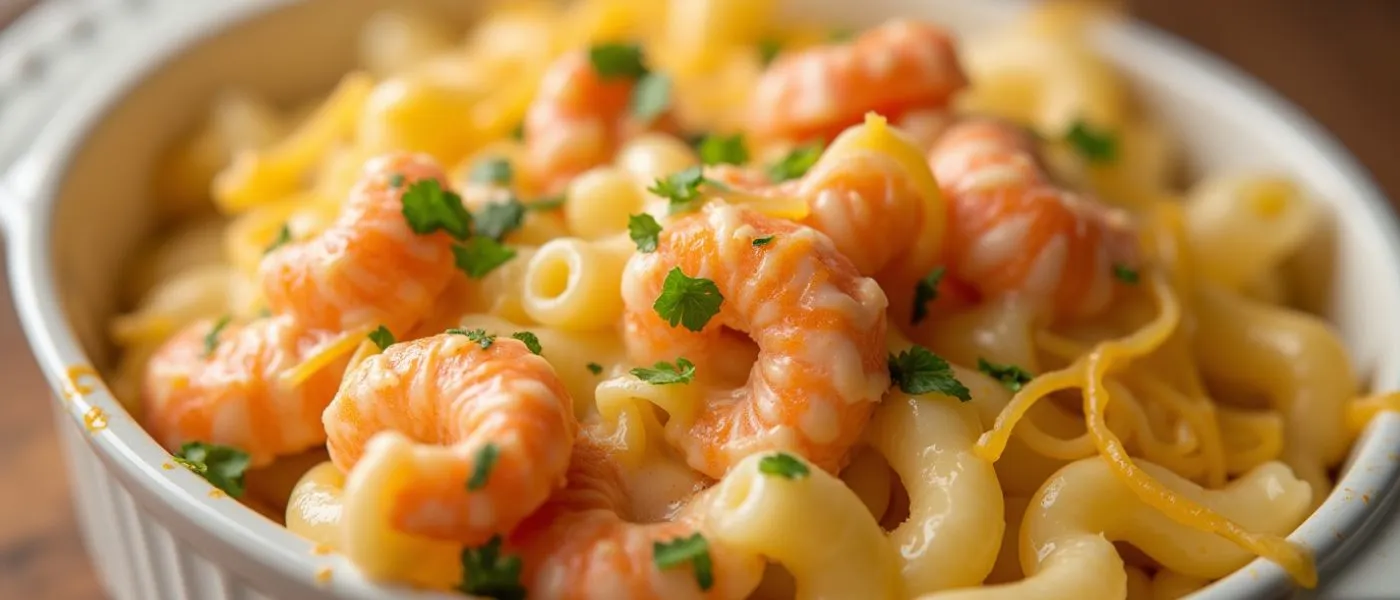Lobster Mac and Cheese – Creamy, Cheesy & Loaded with Flavor
Indulge in the rich flavors of our Lobster Mac and Cheese, a decadent twist on a classic comfort food dish. This creamy, cheesy masterpiece is loaded with succulent lobster, making it a perfect treat for special occasions or a luxurious weeknight dinner.
We will guide you through creating this indulgent recipe, sharing tips and tricks to elevate your cooking experience. With its velvety texture and rich flavor profile, this dish is sure to become a favorite.
Key Takeaways
- Learn how to make a creamy and cheesy Lobster Mac and Cheese.
- Discover the secrets to incorporating succulent lobster into your pasta dish.
- Get tips on elevating your comfort food game with this luxurious recipe.
- Understand the importance of texture and flavor balance in this decadent dish.
- Explore the versatility of this recipe for various occasions.
The Ultimate Comfort Food Elevated
Lobster Mac and Cheese is more than just a dish; it’s an elevated comfort food experience that combines the richness of lobster with the creamy texture of a perfectly cooked macaroni and cheese.
Our recipe is designed to take you on a culinary journey, blending the familiar comfort of macaroni and cheese with the luxurious taste of lobster, making it the best lobster mac and cheese you’ve ever had.
Why This Dish Stands Out
What sets our Lobster Mac and Cheese apart is the quality of its ingredients and the care taken in its preparation. We use chunks of succulent lobster meat, perfectly cooked pasta, and a rich, creamy cheese sauce.
- Succulent lobster meat for a luxurious taste
- Perfectly cooked pasta for the right texture
- A blend of cheeses for a rich and creamy sauce
What to Expect From Our Recipe
Our Lobster Mac and Cheese recipe promises a dish that’s both comforting and sophisticated. You can expect a harmonious balance of flavors, with the sweetness of the lobster complementing the tanginess of the cheese sauce.
By following our recipe, you’ll achieve a lobster macaroni and cheese that’s not only delicious but also visually appealing, making it perfect for both weeknight dinners and special occasions.
What Makes Lobster Mac and Cheese So Special
The allure of Lobster Mac and Cheese lies in its unique blend of luxury and comfort, making it a standout in the culinary world. This dish is not just a meal; it’s an experience that elevates a classic comfort food to new heights with the addition of succulent lobster.
The Perfect Marriage of Luxury and Comfort
Lobster Mac and Cheese represents the perfect fusion of high-end ingredients and comforting nostalgia. The luxurious chunks of lobster add a sophisticated twist to the traditional macaroni and cheese, making it a gourmet lobster mac and cheese experience. This combination is not just about mixing ingredients; it’s about creating a harmonious balance between the richness of the lobster and the creaminess of the cheese sauce.
When preparing homemade lobster mac and cheese, the quality of the ingredients is paramount. The dish relies on the freshness of the lobster, the type of pasta used, and the blend of cheeses to achieve the perfect flavor profile.
| Key Ingredients | Description | Importance |
|---|---|---|
| Lobster Meat | Fresh or frozen chunks of lobster | Provides luxury and flavor |
| Pasta | High-quality macaroni | Foundation of the dish |
| Cheese Blend | Mix of cheddar, parmesan, and other cheeses | Creates the creamy sauce |
A Brief History of This Gourmet Classic
Lobster Mac and Cheese has its roots in traditional comfort food, but its evolution into a gourmet dish is a more recent phenomenon. The addition of lobster to the classic macaroni and cheese recipe has transformed it into a sophisticated meal suitable for special occasions. This gourmet twist on a classic comfort food has made it a favorite in upscale restaurants and home kitchens alike.
The versatility of Lobster Mac and Cheese allows it to be adapted to various tastes and dietary preferences, further enhancing its appeal as a gourmet lobster mac and cheese dish.
Essential Ingredients for Perfect Lobster Mac and Cheese
When it comes to making a truly exceptional Lobster Mac and Cheese, the ingredients are paramount. The dish’s success hinges on the quality and preparation of its core components: lobster, pasta, and cheese. Let’s dive into the specifics of each.
Selecting the Best Lobster

The type of lobster you choose can significantly impact the flavor and texture of your dish. Fresh lobster is ideal for its succulent flavor, but frozen lobster can be a convenient and equally delicious alternative.
Fresh vs. Frozen Lobster
While fresh lobster is often preferred, frozen lobster can be just as good if thawed and cooked properly. The key is to not overcook it, preserving its tender texture.
Lobster Tails vs. Whole Lobster
Lobster tails offer a more straightforward preparation process, providing generous chunks of meat. Whole lobster, on the other hand, can be more flavorful but requires more effort to extract the meat.
Choosing the Right Pasta
The pasta shape and cooking method are crucial for a harmonious Lobster Mac and Cheese. Cavatappi or shells are excellent choices because they hold onto the cheese sauce well.
Best Pasta Shapes for Cheese Sauce
Shapes with nooks and crannies, like cavatappi, are perfect for trapping the creamy cheese sauce, ensuring every bite is flavorful.
Cooking Pasta Al Dente
Cooking pasta al dente is vital. It provides a satisfying texture that complements the creamy sauce and tender lobster.
The Cheese Blend That Makes the Difference
A blend of cheeses is essential for a rich and complex flavor profile. A base of sharp cheddar and Gruyère provides depth, while additional cheeses can add complexity.
Sharp Cheddar and Gruyère Base
Sharp cheddar adds a tangy, rich flavor, while Gruyère contributes a nutty, creamy element to the sauce.
Accent Cheeses for Complexity
Adding cheeses like Parmesan or Fontina can enhance the flavor, adding layers of saltiness and richness to the dish.
| Ingredient | Recommended Choice | Why It Matters |
|---|---|---|
| Lobster | Fresh or high-quality frozen | For the best flavor and texture |
| Pasta | Cavatappi or shells | Holds cheese sauce well |
| Cheese Blend | Sharp cheddar and Gruyère | Provides depth and richness |
Equipment You’ll Need for Lobster Mac and Cheese
Preparing Lobster Mac and Cheese requires more than just great ingredients; it demands the right equipment. To ensure a smooth cooking process and a delightful outcome, it’s essential to be prepared with the necessary kitchen tools and baking dishes.
Essential Kitchen Tools
To start, you’ll need some fundamental kitchen tools. A large pot is necessary for cooking the pasta to the perfect al dente. A colander is also essential for draining the pasta without losing any of it down the drain. For preparing the lobster, a steamer basket is highly recommended, as it allows for gentle cooking and helps retain the lobster’s flavor and texture.
Additionally, a saucepan is required for making the cheese sauce. Opt for one that is medium-sized and has a heavy bottom, as this will help in evenly heating the sauce and preventing it from burning. A whisk is another crucial tool for mixing the sauce ingredients thoroughly, ensuring a smooth and creamy consistency.
| Tool | Purpose |
|---|---|
| Large Pot | Cooking Pasta |
| Colander | Draining Pasta |
| Steamer Basket | Cooking Lobster |
| Saucepan | Making Cheese Sauce |
| Whisk | Mixing Sauce Ingredients |
Baking Dishes and Alternatives
For baking the Lobster Mac and Cheese, you’ll need a suitable baking dish. A 9×13 inch baking dish is ideal, as it allows for an even layer of mac and cheese and a nicely browned top. If you don’t have a baking dish of this size, you can consider alternatives such as individual ramekins for a personalized serving or a large, oven-safe skillet for a more rustic presentation.

When choosing a baking dish, consider the material as well. Ceramic or glass dishes are excellent for even heating and can be used for both baking and serving, making them a practical choice. Ensure that your chosen dish is oven-safe to avoid any potential damage or hazards.
“The right equipment can make all the difference in cooking. It’s not just about the ingredients; it’s about how you prepare them.”
Chef’s Wisdom
Preparing the Lobster
Preparing lobster for your mac and cheese casserole is a straightforward process that requires some care. The quality of the lobster directly impacts the overall flavor and texture of the dish. In this section, we’ll guide you through cooking the lobster to perfection and extracting the meat efficiently.
How to Cook Lobster Perfectly
Cooking lobster can be done through various methods, but boiling and steaming are the most common. Both methods yield delicious results if done correctly.
Boiling Method
To boil lobster, fill a large pot with enough saltwater to cover the lobster. Bring the water to a rolling boil, then gently add the lobster. Cook for 8-10 minutes per pound. Immediately plunge the lobster into an ice bath to stop the cooking process.
Steaming Method
Steaming is a gentler method that helps retain the lobster’s flavor. Place a steamer basket in a pot with a tight-fitting lid. Add water, ensuring it’s below the basket’s bottom. Bring to a boil, then add the lobster. Steam for 8-10 minutes per pound, checking for doneness.
Extracting and Preparing the Meat
Once cooked and cooled, it’s time to extract the lobster meat. This process involves breaking down the lobster and then chopping the meat.
Breaking Down the Lobster
Twist off the claws and legs. Crack the shells using a nutcracker or a mallet, and gently remove the meat. For the body, split it in half lengthwise and scoop out the meat.
Chopping and Seasoning
Chop the extracted meat into bite-sized pieces. Season with salt, pepper, and a squeeze of lemon juice to enhance the flavor. Your lobster is now ready to be incorporated into your mac and cheese casserole.
| Cooking Method | Cooking Time | Flavor Retention |
|---|---|---|
| Boiling | 8-10 minutes/pound | Good |
| Steaming | 8-10 minutes/pound | Excellent |
Creating the Ultimate Cheese Sauce
A rich and creamy cheese sauce is the backbone of a truly exceptional lobster mac and cheese. It’s what transforms a simple pasta dish into a luxurious meal. In this section, we’ll guide you through the process of creating a flawless cheese sauce that will elevate your creamy lobster mac and cheese to new heights.

Making a Flawless Roux
The foundation of a great cheese sauce is a well-made roux. To start, melt 2 tablespoons of butter in a saucepan over medium heat. Once melted, add 2 tablespoons of all-purpose flour, whisking continuously to avoid lumps. Cook for about 2 minutes, or until the roux is lightly golden and has a nutty aroma. This step is crucial as it removes the raw flour taste and adds depth to your sauce.
Incorporating Cheese for Maximum Creaminess
Slowly pour in 2 cups of milk, whisking constantly to prevent lumps. Bring the mixture to a simmer and cook until it thickens. Remove from heat and gradually add 2 cups of grated cheese (a mix of cheddar and Gruyère works well), stirring until fully incorporated. The key to a creamy sauce is to add the cheese gradually and maintain a consistent temperature.
Temperature Control Techniques
To avoid a grainy texture, it’s essential to control the temperature. Keep the sauce over low heat and stir constantly as you add the cheese. If the sauce gets too hot, the cheese can separate, leading to an undesirable texture.
Preventing Grainy Texture
In addition to temperature control, using high-quality cheese and grating it freshly can help prevent a grainy texture. Avoid pre-shredded cheese, as it often contains additives that can affect the sauce’s smoothness.
Seasoning Secrets
Once your cheese sauce is smooth and creamy, it’s time to add some seasoning. A pinch of salt, a grind of black pepper, and a sprinkle of paprika can enhance the flavor. For an extra layer of depth, consider adding a teaspoon of Dijon mustard or a sprinkle of dried thyme. These subtle additions can elevate your lobster mac and cheese to a truly gourmet level.
By following these steps and tips, you’ll be able to create a rich, creamy, and flavorful cheese sauce that complements the succulent lobster and pasta perfectly, resulting in a creamy lobster mac and cheese that’s sure to impress.
Our Signature Lobster Mac and Cheese Recipe
The moment you’ve been waiting for has arrived – our take on the best homemade Lobster Mac and Cheese. This recipe combines the richness of lobster with the comfort of a creamy macaroni and cheese, elevated with a blend of high-quality cheeses and a touch of sophistication.
Ingredients List
For a dish as decadent as Lobster Mac and Cheese, the quality of the ingredients is paramount. Here’s what you’ll need:
- 8 oz macaroni
- 1 lb lobster meat, cooked and diced
- 2 tbsp unsalted butter
- 1/2 cup all-purpose flour
- 2 cups milk
- 1 cup grated Gruyère cheese
- 1/2 cup grated Parmesan cheese
- 1/2 cup grated cheddar cheese
- Salt and pepper, to taste
- Fresh parsley, chopped (optional)
Step-by-Step Instructions
To create this best Lobster Mac and Cheese, follow these steps carefully:
- Preheat and Prepare: Preheat your oven to 375°F (190°C). Cook the macaroni according to package instructions until al dente. Drain and set aside.
- Make the Roux: In a large saucepan, melt the butter over medium heat. Add the flour and whisk until it forms a smooth, light golden paste. Gradually pour in the milk, whisking continuously to avoid lumps. Bring to a simmer until the sauce thickens.
- Add Cheese: Remove the saucepan from the heat. Stir in the Gruyère, Parmesan, and cheddar cheese until melted and smooth. Season with salt and pepper.
- Combine with Lobster and Macaroni: In a large mixing bowl, combine the cooked macaroni, lobster meat, and cheese sauce. Mix until the pasta is well coated.
- Bake: Transfer the macaroni mixture to a baking dish, top with additional grated cheese if desired, and bake for 20-25 minutes, or until golden brown on top.
Cooking Times and Temperatures
To ensure your homemade Lobster Mac and Cheese turns out perfectly, pay attention to these cooking times and temperatures:
- Macaroni: Cook according to package instructions, typically 8-10 minutes.
- Cheese Sauce: Simmer for 5-7 minutes, or until thickened.
- Baking: 20-25 minutes at 375°F (190°C).
Troubleshooting Your Lobster Mac and Cheese
Making gourmet lobster mac and cheese is a bit of an art, and we’re here to help you troubleshoot. Even with the best recipe, things can go wrong, but with our tips, you’ll be able to overcome common issues and achieve a creamy, cheesy masterpiece.
Common Problems and Solutions
Let’s face it, sometimes the sauce can be too thin or too thick, and the pasta might not be cooked just right. Here are some solutions to these common problems.
Sauce Too Thin or Too Thick
If your sauce is too thin, try simmering it for a few minutes to reduce the liquid. If it’s too thick, you can thin it out with a bit of milk or cream. The key is to achieve a smooth, creamy consistency that coats the pasta perfectly.
Undercooked or Overcooked Pasta
To avoid undercooked or overcooked pasta, check it frequently while it’s boiling. You want it to be al dente – firm in the center but not hard. If you end up with overcooked pasta, you can try salvaging it by mixing it with the cheese sauce and baking it in the oven for a few minutes.
Make-Ahead Tips and Storage
Lobster mac and cheese is a great dish to make ahead, and with our tips, you can enjoy it at your convenience. Here are some guidelines for refrigeration and freezing.
Refrigeration Guidelines
You can refrigerate lobster mac and cheese for up to 3 days. Simply cover it tightly with plastic wrap or aluminum foil and store it in the fridge. When you’re ready to serve, bake it in the oven until it’s hot and bubbly.
Freezing and Reheating
To freeze, let the dish cool completely, then cover it with plastic wrap or aluminum foil and store it in the freezer for up to 2 months. To reheat, thaw it overnight in the fridge, then bake it in the oven until it’s hot and golden brown.
| Storage Method | Timeframe | Reheating Instructions |
|---|---|---|
| Refrigeration | Up to 3 days | Bake in oven until hot and bubbly |
| Freezing | Up to 2 months | Thaw overnight, bake in oven until hot and golden brown |
Delicious Variations of Lobster Mac and Cheese
Lobster Mac and Cheese is a canvas waiting for your personal touch; let’s explore some delicious variations. While the classic recipe is undeniably decadent, experimenting with different ingredients can elevate this comfort food to new heights. Whether you’re looking to add more seafood, try new spices, or accommodate dietary restrictions, we’ve got you covered.
Adding Additional Seafood
For seafood lovers, adding other types of seafood can enhance the flavor and texture of Lobster Mac and Cheese. Consider incorporating shrimp, crab meat, or even mussels to create a seafood medley.
- Shrimp adds a sweet and tender element.
- Crab meat contributes a flaky texture and rich flavor.
- Mussels bring a brininess that complements the lobster.
Herb and Spice Variations
Herbs and spices can dramatically change the flavor profile of your Lobster Mac and Cheese. Try adding truffle oil for an earthy note, paprika for a smoky flavor, or fresh parsley for a fresh twist.
| Herb/Spice | Flavor Profile |
|---|---|
| Truffle Oil | Earthy, luxurious |
| Paprika | Smoky, slightly sweet |
| Fresh Parsley | Fresh, green |
Gluten-Free and Dietary Adaptations
For those with dietary restrictions, it’s easy to adapt Lobster Mac and Cheese. Use gluten-free pasta and be mindful of the cheese sauce ingredients to ensure they’re gluten-free. For a vegan version, substitute the cheese with vegan alternatives and use plant-based milk.
“The key to a great gluten-free mac and cheese is using the right pasta and a well-balanced cheese sauce.”
Conclusion
We’ve explored the world of Lobster Mac and Cheese, a culinary delight that combines the richness of lobster with the comfort of macaroni and cheese. This dish is perfect for special occasions or a cozy night in. Our recipe for lobster mac and cheese casserole brings together the finest ingredients, including succulent lobster meat, creamy cheese sauce, and perfectly cooked pasta.
By following our step-by-step guide, you can create a truly decadent lobster mac and cheese that will impress your family and friends. Feel free to experiment with variations, such as adding additional seafood or trying different herbs and spices, to make the dish your own.
Whether you’re a seasoned chef or a culinary novice, our lobster mac and cheese recipe is sure to become a favorite. So go ahead, give it a try, and indulge in the rich, cheesy goodness of this beloved comfort food classic.
FAQ
What is the best type of lobster to use for Lobster Mac and Cheese?
We recommend using fresh lobster for the best flavor, but frozen lobster can be a good alternative. When choosing between lobster tails and whole lobster, consider that whole lobster provides a more varied texture and flavor, while lobster tails offer a more straightforward preparation process.
How do I prevent my cheese sauce from becoming grainy?
To prevent a grainy texture, it’s essential to control the temperature when incorporating cheese into the sauce. Gradually add the cheese, stirring constantly, and avoid overheating the sauce. Using a combination of cheeses, such as sharp cheddar and Gruyère, will also help achieve a smooth and creamy texture.
Can I make Lobster Mac and Cheese ahead of time?
Yes, you can prepare Lobster Mac and Cheese in advance. To do so, assemble the dish up to the point of baking, then refrigerate or freeze it. When refrigerating, bake the dish within a day or two, and when freezing, bake it within a month. Reheat the dish in the oven until it’s hot and bubbly.
What are some common issues with cooking pasta for Lobster Mac and Cheese, and how can I avoid them?
Common issues include undercooking or overcooking the pasta. To avoid these, cook the pasta al dente, as it will continue to cook a bit during the baking process. Regularly check the pasta’s texture during cooking, and shock it in cold water after draining to stop the cooking process.
How can I adapt the Lobster Mac and Cheese recipe to be gluten-free?
To make a gluten-free version, substitute the traditional pasta with a gluten-free alternative, and be mindful of the ingredients in your cheese sauce and other components. Some cheeses and seasonings may contain gluten, so choose gluten-free options to ensure the dish is safe for those with gluten intolerance or sensitivity.
What are some variations I can try to give Lobster Mac and Cheese a unique twist?
Consider adding other seafood like shrimp or crab to enhance the dish’s flavor and texture. You can also experiment with different herbs and spices, such as truffle oil or paprika, to add depth and complexity. For dietary adaptations, try using vegan cheese alternatives or gluten-free pasta to cater to various tastes and dietary needs.
Leave a Review & Rate This Recipe!
There are no reviews yet. Be the first one to write one.

